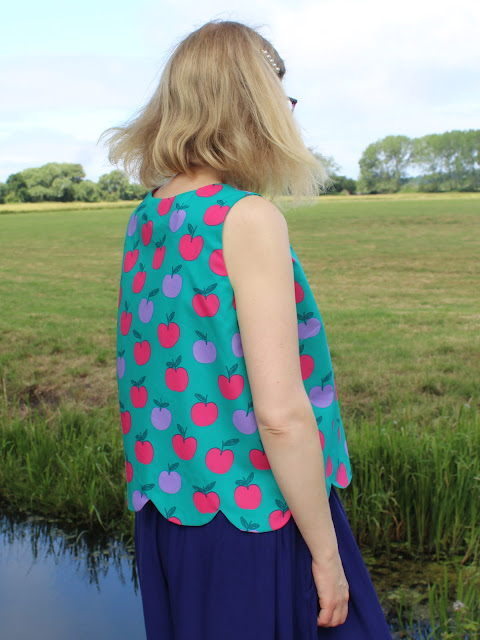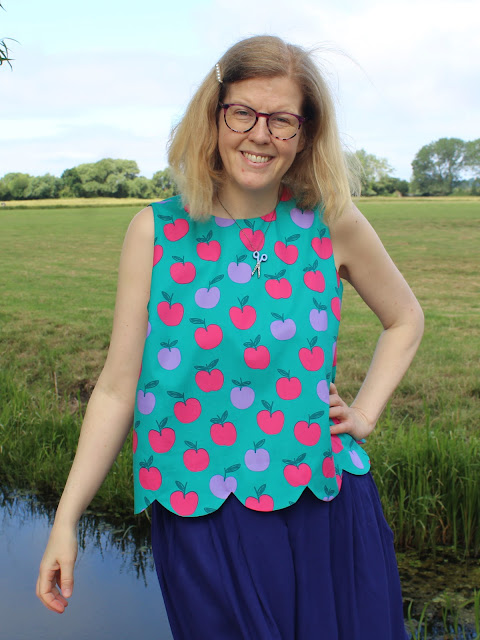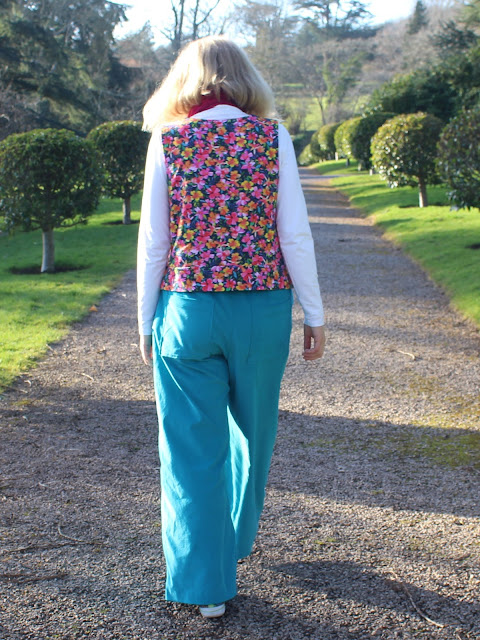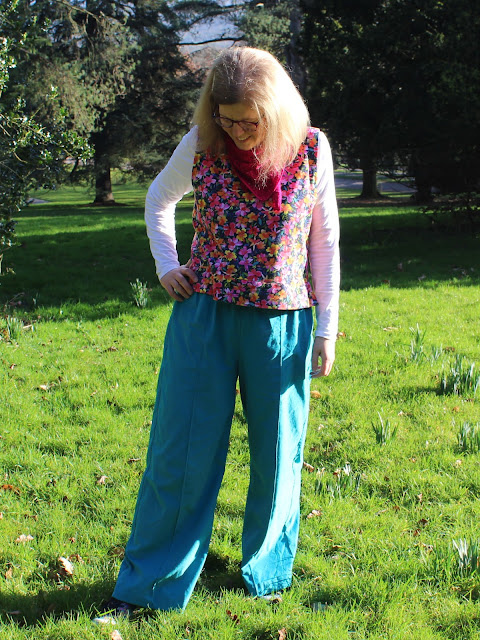Thursday, 16 October 2025
McCall's 8553 zip front dress
Monday, 30 June 2025
Sew Hello St Mawes Top
Thursday, 19 June 2025
Simplicity 8384 dress
I enjoy hunting out bargains in charity shops, and always keep an eye out for sewing patterns. A couple of months ago I stumbled upon a box of patterns and treated myself to a couple of them, one of which was Simplicity 8384. I particularly liked the look of view A, which is what I've sewn here.
Simplicity 8384 is a shirt dress or top with various length options. All the views have a collarless rounded neckline, and buttons at the centre front of the bodice. There are sleeveless, short sleeve and three-quarter sleeve options. The dress has a handkerchief hem for the knee and mid-calf lengths, and a straight hem for the ankle length and peplum top versions. The back of the waistline is cinched in slightly with elastic.
The pattern covers bust measurements from 30.5" to 46".
I enjoyed sewing my dress. The neckline/collar band in particular turns out really nicely and was very satisfying to sew.
The instructions in Big 4 sewing patterns often get a bad reputation, but I usually find them clear and easy to follow. They maybe don't hold your hand as much as indie patterns and they're generally a lot more concise, but that's not necessarily a bad thing. I had no problems while I was making my dress.
That said, I did take a slightly different approach to inserting the elastic in the back of the waistline. The instructions call for you to sew the edges of the seam allowances together to make a channel and insert the elastic into that. I thought that might be irritating to wear because the seam allowance could move about. Instead, I pressed the seam allowance up and made my channel by stitching the seam allowance to the back bodice to anchor it in place. It worked nicely, and isn't irritating at all (although, to be fair, I don't have any evidence that the version from the pattern would have been irritating either!).
Another thing that Big 4 patterns are renowned for is having lots of ease, and that's very much true for this pattern. It's definitely always best to look at the finished garment measurements (on the pattern paper) – I think in this case the pattern includes 5" of ease.
That would have given me a dress that was looser than I wanted, so I went down a couple of sizes. I made a straight size 14, whereas my measurements would put me between a 16 and an 18.
I lengthened the bodice by an inch, which is normal for me (I'm 5'9"), and actually shortened the skirt by 3". Those skirt pieces are long! It's intended to be ankle length, but it would have been on the floor if I hadn't shortened it, and I'm a bit taller than average.
It's also worth mentioning that if you have a non-directional print/plain fabric without nap, you can definitely get view A out of less fabric than the pattern suggests. It calls for 3.4 metres for size 14, but I managed to cut my dress out of just over 2.5 metres.
Talking about fabric, this is a cotton poplin that I bought from Minerva but I can't seem to find it on their website now – sorry!
My finished Simplicity 8384 feels lovely to wear – the elastic in the back waist cinches it in nicely to give it some shape, but it's still really comfortable. It's a bit different from my other dresses, which is nice. I'm glad that I found the pattern in that charity shop box!
Thursday, 24 April 2025
Pauline Alice Nautic Set Blouse
The Pauline Alice Nautic set appealed to me as soon as I saw sneak peeks of it on Instagram, so I was fairly quick to purchase the pattern when it was released. I already had some fabric that was just right for the blouse, so it jumped to the top of my sewing list.
The Nautic set includes a blouse, skirt and shorts. The blouse, which I've made here, has a sailor collar, short sleeves, decorative binding/ribbon and front buttons. The shorts have an elasticated waist, slanted pockets and contrasting bias binding, while the skirt has an elasticated waist and gathered tier.
The pattern covers bust sizes from 31½" to 47¼" and hip measurements from 34" to 49½".
I enjoyed sewing my Nautic blouse. The instructions and accompanying diagrams are easy to follow. They maybe don't hold your hand quite as much as some instructions do, but they're still perfectly clear and I didn't have any trouble sewing my blouse.
The pattern is rated as beginner level, which I'd say is probably fair. You probably wouldn't want to sew the blouse as your very first pattern, but if you've made a couple of projects and are looking for something to build your skills a bit, this could be a good option.
You need to be quite careful and accurate when sewing the decorative ribbon/binding, but other than that it's a fairly simple blouse.
In terms of sizing, my bust is currently 39" but I made a size 42, which is intended for a 38" bust. I could tell from the finished garment measurements that it would be big enough, and that the next size up would probably be bigger than I wanted.
After making a toile, the only adjustment I made was to lower the bust dart by an inch.
Rather than lengthening the pattern (I'm just under 5'9"), I simply used a smaller hem. I used a total of 1" for my hem, whereas the pattern calls for you to use 2⅝".
Another non-fitting change that I made was to interface the facing pieces. This isn't included in the instructions, but I just thought that it would give a better finish.
I also used 5 buttons instead of 3. It's a personal preference, but I just felt like 3 buttons wouldn't be quite enough and might result in gaping.
The main fabric that I used is a lightweight cotton that I bought in a charity shop a few months ago, and the white that I used for the collar is part of an old sheet. So this was a pretty thrifty project! I bought the ribbon and the buttons locally, and I love how they highlight the little pops of pink in the fabric print.
I'm really pleased with how my Nautic blouse turned out, and I like the fact that the collar makes it a bit different to other blouses in my wardrobe. I'd definitely like to try making the skirt from the set too, so there may well be more Nautic projects in my future!













































